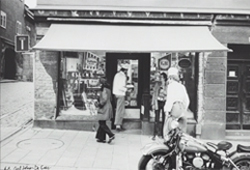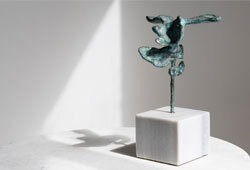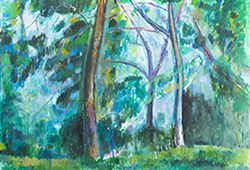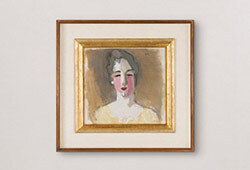Modern Art & Design presents Gösta Adrian-Nilsson
Gösta Adrian-Nilsson, 'Farväl till Maimuna (Sjömansvisa)'
Gösta Adrian-Nilsson (GAN) has, like few other Swedish artists, forged his path and challenged the norms of his time. One way he did this was by choosing to use masculine sailors as subjects for his paintings, which led to his art being seen as a form of 'protest art' and as an expression of his homosexuality. It should be noted that this was in the early 20th century, a time when homosexuality was still taboo and illegal in Sweden. Using sailors as subjects was also a way for GAN to illustrate his own desire to experience other parts of the world that were foreign to him by virtue of both his environment and his culture. GAN was not able to travel as often or as far as he wanted, but through his work, he took the viewer on journeys to distant places such as Samoa in Polynesia.
From 1920 to 1925, GAN lived in Paris, with breaks in the summers of 1922 and 1923 for stays in Lund and Halmstad. In October 1921, the musician Matti Rubinstein gave him a small two-room apartment at 86, rue Nôtre-Dame-des-Champs in Montparnasse. In the same building, Fernand Léger had his studio and later on the street level his famous school, the Académie Moderne. GAN, who was already moving away from his 'kaleidoscopic' cubism towards a synthetic cubist style around 1919/20, made contact with Léger during his first summer in Paris in 1920, who kindly welcomed him into his studio and a collegial exchange of ideas developed.
Although GAN took certain influences from Léger, the synthetic cubist style he developed in Paris is quite different from Léger's austere 'machine cubism'. GAN's cubism is more detailed, varied and dynamic, and in the early 1920s he reintroduced human figures such as athletes, soldiers and sailors into his work. GAN would return to more abstract expressions towards the end of the 20th century, when he also engaged in surrealist experiments. One of his main strengths was his ability to draw inspiration from a variety of expressions without ever resorting to imitation.

› Signed GAN. Executed in the 1920s. Canvas 61 x 46 cm.
The auction's painting 'Farewell to Maimuna (Sea Song)' is an outstanding example of how GAN's individualistic artistic experimentation took shape. The work's powerful composition and strong, contrasting yet harmonizing color scheme combined to embody his expressive style. In the scene, the viewer encounters the sailor bidding farewell to his beloved Maimuna in the classic sailor's song 'Adieu To Maimuna'. The composition takes the viewer on a journey that unites new worlds.
The work will be sold at Modern Art & Design.
Estimate 800 000 - 1 000 000 SEK
Viewing: May 16 – 20, Bukowskis, Berzelii Park 1, Stockholm
Open: weekdays 11 am – 6 pm, weekends 11 am – 4 pm
Live auction: May 21– 22, Arsenalsgatan 2, Stockholm
To the work
Read more about Modern Art & Design and see the full catalogue

Requests & condition reports Contact specialist

Tukholma
Andreas Rydén
Varatoimitusjohtaja, Johtava asiantuntija, taide
+46 (0)728 58 71 39

Tukholma
Lena Rydén
Johtava taideasiantuntija, moderni- ja 1800-luvun taide
+46 (0)707 78 35 71

Tukholma
Amanda Wahrgren
Asiantuntija, moderni taite ja grafiikka
+46 (0)702 53 14 89

























